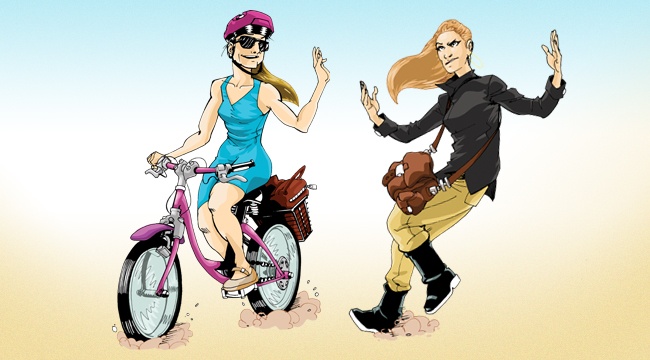Bike Battles
Our relationship with transportation and mobility in our cities is a wobbly one. Even before Calgary launched its cycle-track pilot project last spring, citizens were taking sides — some cheering the $5.75-million investment, others citing safety concerns and parking pressures as reasons enough not to embrace the initiative. Perfect or not, Calgary’s Cycle Track Network’s time has come. Or has it? We turn to the experts…
Currently on leave from the City of Calgary’s transportation planning business unit, Blanka Bracic, BA’01, BSc (Eng)’01, MA’04, is now working on an MSc in urban planning in Stockholm. And spins to school.
Should we have bike lanes in Calgary’s downtown core?
Transportation choices are important if cities are to attract business investment and educated workers. We know through studies in Calgary and other cities in North America that more people will ride bikes, (up to six per cent of trips to work or school), when bike lanes and low-stress routes on residential streets are offered. With 2.5 per cent of inbound workers entering the downtown core by bicycle in the busiest hour of the morning, Calgary has plenty of potential to get more people riding.
Due to our long winters, some people say we have a short cycling season. Is the new cycling infrastructure too elaborate for the amount of time the lanes will actually be used?
No. Calgary gets less snow and more sunny days than some other bike-friendly cities such as Minneapolis and Montreal. In fact, we know that 30 per cent of summer bike riders on Calgary’s 10 Street N.W. bike lane and the 7 Street S.W. cycle track ride in the winter. Just like car lanes and sidewalks — bike lanes and cycle tracks need to be cleared of snow so people see them as a reliable way to get around.
There is a small percentage of people that use the lanes on a regular basis or as their main mode of transportation. Should all Calgarians be paying for the lanes (via tax dollars)?
Bike lanes or cycle tracks are part of a bicycle transportation system and, like other transportation systems, they remain the responsibility of local government. We also need to remember that the small percentage of people who use the cycle tracks is because Calgary does not have a closely spaced grid of bike routes. The more routes we build for bike riding, the more cycling we’ll see.
Are we creating a higher likelihood of a car/cyclist accident by “allowing” cyclists to interact with traffic so closely?
Over time, people will get used to the predictability of the setup: pedestrians will have their space, as will cyclists and drivers. Our research on 7 Street S.W. shows that most bike riders will choose the cycle track over the travel lane or the sidewalk. According to research in B.C., riding a bike in a cycle track is nine times safer than riding on a similar multi-lane road without any dedicated bike space at all.
Would you like to see a bike-share program built into our infrastructure so we become known as a bike-friendly destination?
Yes. A bike-share program will make it easy for someone to grab a bike for a last-minute trip to meet a friend or get to a meeting. We’re already seeing bike-riding over the Peace Bridge featured in tourism promotional materials. More evidence is apparent in the huge numbers of cyclists that use the Legacy Trail that now links Banff with Canmore.










